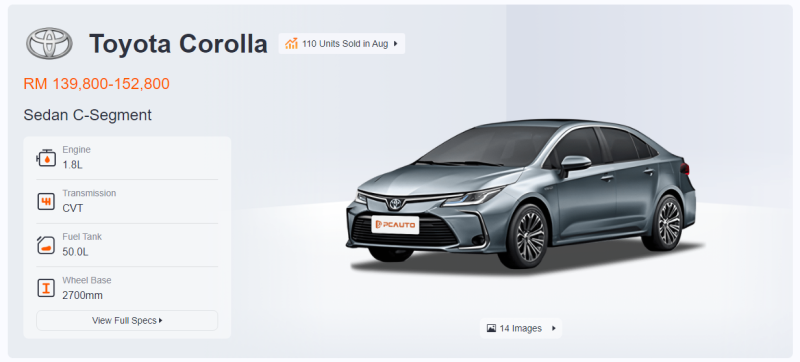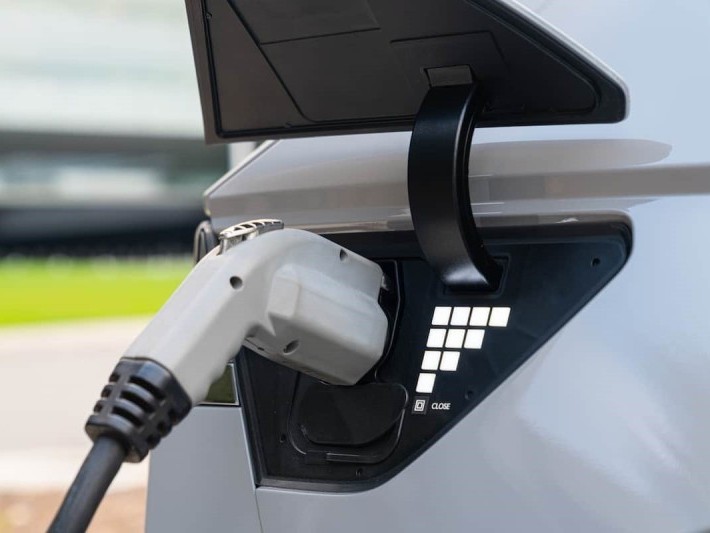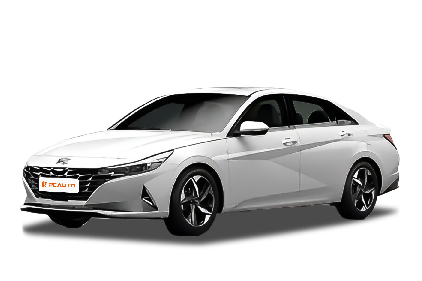Q
Which model year of Hyundai Elantra is good?
Different model years of the Hyundai Elantra each have their own advantages. The 2018 Hyundai Elantra 2.0 Executive, priced at RM 109,888, is equipped with a 2.0L naturally aspirated engine delivering a maximum horsepower of 152PS, offering relatively robust performance, along with a 5-year or 300,000 km vehicle warranty. However, as a previous-generation model, it falls slightly behind in terms of technological and feature advancements.
The 2021 Hyundai Elantra has Executive and Premium variants, priced at RM 139,888 and RM 158,888 respectively. The Executive version provides practical configurations suitable for daily driving, while the Premium version adds active safety systems such as lane departure warning and autonomous emergency braking, along with enhanced comfort features like advanced seat adjustments, improving both safety and comfort. It is powered by a 1.6L naturally aspirated engine, prioritizing fuel efficiency.
For those prioritizing power, the 2018 model's 2.0L engine is the better choice. However, if fuel economy, safety, and upgraded comfort features are key considerations, the 2021 model would be the more suitable option.
Special Disclaimer: This content is published by users and does not represent the views or position of PCauto.
Related Q&A
Q
What oil filter does a 2021 Hyundai Elantra take?
The 2021 Hyundai Elantra (known as Hyundai Elantra or Avante in the Malaysian market) typically uses an oil filter with the original part number 26300 - 35505. This is a model specifically designed for Hyundai Gamma series 1.6L and 2.0L engines and is compatible with mineral oil, semi - synthetic, and fully synthetic oils.
In Malaysia, car owners can also choose certified aftermarket filters from well - known brands such as MANN Filter W811/80, Fram PH9688, or Bosch 3330. These products are easily available at local auto parts stores or e - commerce platforms like Lazada and Shopee.
When selecting an oil filter, pay attention to its filtration efficiency (it is recommended that the β value be ≥ 20), burst pressure resistance (≥ 200 psi), and the material of the rubber seal ring (fluororubber is more durable). These parameters directly affect the engine protection effect.
It is recommended to replace the filter every 5,000 to 10,000 kilometers or every 6 months (depending on the type of oil and driving conditions). In tropical climates like Malaysia's hot and dusty environment, the replacement cycle can be appropriately shortened.
If you replace the filter yourself, you need to use a filter wrench with a 74 - 80mm specification. Also, remember to apply a thin layer of oil on the seal ring of the new filter to ensure a good seal.
Hyundai's authorized service centers in Malaysia, such as Hyundai - Sime Darby Motors, also offer original maintenance packages that include filters and oils that meet the specifications, which is suitable for car owners who pursue original warranty services.
Q
Does a 2021 Hyundai Elantra need synthetic oil?
For the 2021 Hyundai Elantra in the Malaysian market, synthetic oil is recommended. The original manufacturer suggests using 5W - 20 or 5W - 30 full - synthetic oils that meet the API SP or ACEA C2 standards. This type of oil can better adapt to the high - temperature working conditions in the tropical climate, providing excellent anti - wear protection and cleaning performance. At the same time, it can extend the oil change interval to about 10,000 kilometers or 6 months.
Hyundai's Smartstream engines use precision components. The high - temperature stability and low - temperature fluidity of synthetic oil can fully protect the turbocharger and GDI fuel system, preventing sludge buildup in Malaysia's stop - and - go traffic conditions. Car owners need to pay attention to choosing oils with ILSAC GF - 6 certification to ensure fuel economy. The hot and humid local environment may accelerate oil oxidation, so regularly checking the oil level is more important than the intervals specified in the manual.
If you often drive short distances or idle for long periods, you can consider shortening the oil change interval to 8,000 kilometers. However, there's no need to deliberately pursue higher - grade oils. Just follow the viscosity range specified in the manual. Some repair shops may recommend mineral oil to reduce costs, but long - term use may affect the engine's lifespan, especially for models equipped with CVVT technology.
Q
How to check oil life in 2021 Hyundai Elantra?
To check the oil life of the 2021 Hyundai Elantra, first start the vehicle and enter the dashboard menu. Use the control buttons on the right side of the steering wheel to find the "Oil Life" option, then press the "OK" button to view the remaining percentage. This system estimates the oil condition by integrating data such as engine running time, RPM, and temperature through an algorithm. It is recommended to change the oil every 5,000 to 8,000 kilometers or every 6 months, whichever comes first. However, considering the hot climate in Malaysia and the frequent start - stop driving conditions, the actual interval should be appropriately shortened.
It's worth noting that Hyundai's intelligent oil monitoring system can more accurately reflect the actual oil consumption, which is more scientific than traditional fixed - interval maintenance. Nevertheless, you still need to regularly check the dipstick to ensure the oil level is between MIN and MAX. If the oil warning light appears on the dashboard, immediate maintenance is required.
For Malaysian car owners, it is recommended to choose fully synthetic oil that meets API SP or ACEA C2 standards to cope with the high - temperature environment. At the same time, develop the habit of manually checking the oil every month when the vehicle is cold. This is especially important for turbocharged models, as it can effectively prevent engine wear caused by oil film rupture.
Q
How often does a 2021 Hyundai Elantra need an oil change?
According to the official recommendation of Hyundai, for the 2021 Hyundai Elantra in Malaysia, under normal driving conditions, it is recommended to change the engine oil every 10,000 kilometers or 12 months, whichever comes first. If you often drive in high - temperature, dusty or short - distance congested road conditions, you may consider shortening the interval to every 5,000 to 7,500 kilometers to protect the engine. The hot and humid climate in Malaysia may accelerate the deterioration of engine oil performance. Therefore, it is also important to regularly check the condition of the engine oil (such as color and viscosity). At the same time, it is recommended to use fully synthetic engine oil of API SP or ACEA C2/C3 grade recommended by the original manufacturer to ensure the best lubrication and cleaning effects. The Smartstream engine technology equipped in the Hyundai Elantra is quite sensitive to the quality of engine oil. Following the maintenance schedule can effectively extend the engine's lifespan and maintain fuel economy. Car owners can also track the next maintenance time through the in - vehicle maintenance reminder system or the MyHyundai app. It should be noted that there may be slight differences in Elantras of different years or versions. For specific information, you can refer to the vehicle handbook or consult the authorized service center in Malaysia for personalized advice.
Q
What transmission is in the 2021 Hyundai Elantra Preferred?
The 2021 Hyundai Elantra Preferred available in the Malaysian market is equipped with an Intelligent Variable Transmission (IVT). This gearbox is an advanced technology independently developed by Hyundai. By mimicking the shifting logic of traditional automatic transmissions, it offers a smoother driving experience and higher fuel efficiency, making it particularly suitable for the frequent stop - and - go traffic conditions in Malaysian cities.
The IVT gearbox features a chain - drive design. Compared with the steel - belt structure of traditional CVTs, it is more durable. Additionally, it comes with multiple driving modes (such as Eco/Sport) to meet different driving needs. It's worth mentioning that Hyundai offers a 5 - year or 300,000 - kilometer warranty (whichever comes first) for this gearbox, giving Malaysian car owners more peace of mind when using their vehicles.
Among models in the same class, Elantra's IVT technology is well - known for its low maintenance costs. You just need to regularly change the transmission fluid to keep it in good condition. It is more suitable for the hot and humid climate in Malaysia compared to dual - clutch transmissions.
If you have higher requirements for the driving experience, you can also consider the 7 - speed dual - clutch transmission offered in the Elantra N Line version. However, the Preferred version is mainly targeted at family - use comfort, and the IVT remains a more cost - effective and practical choice.
Q
What battery does a 2021 Hyundai Elantra take?
The 2021 Hyundai Elantra in the Malaysian market typically uses a 12V lead - acid battery. Specifically, it is recommended to use the 55D23L (suitable for the 1.6L and 2.0L gasoline engine versions) or a maintenance - free battery with a capacity of 60Ah or more. The cold cranking amps (CCA) are recommended to be above 500A to ensure starting performance in tropical climates. When choosing a battery, pay attention to whether the terminal position (positive on the right) and battery size (approximately 232mm×173mm×225mm) match the original factory. It is recommended to give priority to original - equipment brands such as Hyundai Mobis or well - known third - party brands such as Panasonic and Varta.
For the hybrid version, a dedicated lithium - ion battery pack is required. In such cases, it is recommended to go directly to a Hyundai authorized service center. In daily use, it is recommended to check the battery's health every two years. Especially in the high - temperature and high - humidity climate of Malaysia, the battery life may be shortened to 2 - 3 years. Regularly cleaning the electrode terminals and avoiding long - term short - distance driving can extend the battery life. If you notice slow starting or dimming headlights, check the voltage immediately.
Hyundai's intelligent power management system will actively optimize the charging efficiency, but installing too many electronic devices may increase the battery load. When purchasing, you can consider high - performance batteries with EFB (Enhanced Flooded Battery) or AGM (Absorbent Glass Mat) technology to meet higher power demands.
Q
What oil does the 2021 Elantra use?
For the 2021 Hyundai Elantra in Malaysia, it is recommended to use fully synthetic engine oil with a viscosity of 5W - 20 or 5W - 30 that meets API SP standards or higher. The specific choice should refer to the instructions regarding climate conditions and driving habits in the user manual. In hot climates or during aggressive driving, 5W - 30 can be prioritized to provide better high - temperature protection. Hyundai usually recommends using Hyundai Premium engine oil or products of certified brands such as Shell and Castrol with the same specifications. It is advised to change the oil every 10,000 kilometers or 12 months, whichever comes first.
It's worth noting that in the oil viscosity numbers, the "W" stands for winter performance. The smaller the first number, the better the low - temperature fluidity; the larger the second number, the stronger the high - temperature protection. In Malaysia's year - round high - temperature environment, proper attention can be paid to the high - temperature viscosity index. Turbocharged models have higher requirements for oil cleanliness and anti - shear performance. Be sure to choose fully synthetic oil and strictly follow the maintenance cycle.
If the vehicle is still under warranty, it is recommended to use the engine oil specified by the manufacturer to avoid warranty disputes. Meanwhile, regularly checking the oil level can help detect potential engine problems in a timely manner.
Q
Does the 2021 Elantra have CVT?
The 2021 Hyundai Elantra models available in the Malaysian market are indeed equipped with a CVT (Continuously Variable Transmission). This transmission is renowned for its smooth shifting experience and fuel efficiency, making it particularly well-suited for urban driving environments. CVT technology continuously adjusts the gear ratio, keeping the engine consistently within its most efficient RPM range. This enhances fuel efficiency while minimizing the jerky shifts associated with traditional automatic transmissions. While CVT is the primary transmission option in Malaysia, certain overseas markets may offer alternatives like dual-clutch transmissions (DCT) or manual transmissions. For drivers prioritizing daily commuting comfort and fuel economy, the CVT represents an ideal choice. Hyundai has tuned this transmission to balance responsiveness with reliability. When considering a used or new vehicle purchase, verify specific configurations through official channels and schedule a test drive to experience the CVT's performance firsthand. Additionally, regular transmission fluid maintenance and adherence to manufacturer-recommended service intervals will extend the CVT's lifespan.
Q
Is the 2021 Hyundai Elantra 2.0 L?
The 2021 Hyundai Elantra does offer a 2.0-liter naturally aspirated engine version in the Malaysian market. This engine has a maximum output power of 149 horsepower and a peak torque of 179 Nm. It is paired with a 6-speed automatic transmission, focusing on a smooth driving experience and fuel economy, which is suitable for daily commuting needs. The model adopts Hyundai's latest "Sensuous Sportiness" design language, making its appearance more sporty. At the same time, it comes standard with an 8-inch touchscreen, Apple CarPlay/Android Auto, and the Hyundai SmartSense active safety system, showing outstanding cost - effectiveness.
It's worth mentioning that the Elantra in the Malaysian market is different from the 1.6-liter turbocharged version in some overseas markets. The 2.0-liter naturally aspirated engine is more suitable for the local road conditions and fuel quality, and its maintenance cost is relatively low. In recent years, Hyundai has been continuously making efforts in the Malaysian market. As its main sedan product, the Elantra is more competitive than Japanese models in the same class in terms of space performance and technological configuration. Especially, the five - year unlimited - mileage warranty policy can make consumers use the car more at ease.
If you value practicality and the richness of configurations, this car is worth considering. Of course, it is recommended to take a test drive to see if the power performance meets your personal expectations.
Q
What kind of engine is in the 2021 Elantra essential?
The 2021 Hyundai Elantra Essential is equipped with a 1.6-liter Gamma naturally aspirated four-cylinder engine. It has a maximum output power of 123 horsepower and a peak torque of 154 Nm, paired with a 6-speed automatic manual transmission (6AT). This engine is well - known for its reliability and fuel economy, making it suitable for both urban commuting and long - distance driving in Malaysia.
Compared with turbocharged engines, naturally aspirated engines have a simpler structure and lower maintenance costs, which is ideal for consumers who value practicality. Moreover, this engine meets the emission standards of the Malaysian market. As an entry - level model, the Elantra Essential's power configuration strikes a balance between the smoothness of daily driving and fuel efficiency. It's a great choice for Malaysian consumers with limited budgets but a preference for brand reliability.
The linear power output of the naturally aspirated engine in the high - speed range is also well - suited to the mountainous road conditions in Malaysia. The shifting logic of the 6AT transmission has been optimized to ensure both comfort and response speed.
Latest Q&A
Q
What is the difference between the 2024 and 2025 BMW 5 Series?
There are some differences between the 2024 and 2025 BMW 5 Series models. In terms of pricing, the 2024 520i starts at RM 332,800, with the 520i M Sport variant coming in at RM 349,800. The 2025 530i M Sport, on the other hand, is priced at RM 399,800.
Under the hood, the 2024 520i engines deliver either 210PS or 208PS, while the 2025 530i M Sport ups the ante with a 258PS powerplant. Performance-wise, the 2024 models top out at 230km/h and sprint from 0-100km/h in 7.5 seconds. The 2025 model pushes that top speed to 250km/h and shaves the 0-100km/h time down to just 6.2 seconds.
Looking at the specs, some 2024 trims have rear seats with manual adjustments or fixed configurations, whereas the 2025 model gets a 40:20:40 split-folding rear seat setup. Audio systems also see an upgrade: most 2024 models feature Harman Kardon speakers, while the 2025 model steps up to a Bowers & Wilkins surround sound system.
Additionally, the 2025 5 Series hit dealerships on March 13, 2025, and comes with a 2-year unlimited mileage warranty. The 2024 models first arrived on September 2, 2024.
Q
How much is insurance for a 2024 BMW 5 Series?
The insurance cost for the 2024 BMW 5 Series in Malaysia varies based on several factors, typically ranging from RM5,000 to RM15,000 annually. The exact amount depends on the vehicle model (such as 520i, 530e, or M550i), engine displacement, the owner's age, driving record, type of policy (comprehensive or third-party), and the insurance company's discount policies. For instance, the high-performance M550i, with its higher repair costs, will have significantly higher premiums than the entry-level 520i, while the hybrid 530e may qualify for partial insurance discounts due to its eco-friendly features. Additionally, Malaysia's insurance market is influenced by the No Claim Discount (NCD), where drivers with consecutive claim-free years can enjoy a maximum 55% reduction in premiums. It's advisable to obtain accurate quotes through insurance company websites or comparison platforms before purchasing a car, and also to understand the additional services offered by Malaysian car insurance, such as roadside assistance or windscreen coverage, as these details can impact the final decision. Notably, luxury car insurance usually includes higher third-party liability coverage limits to comply with local regulatory requirements, and owners can also adjust the excess amount according to their needs to balance premium costs.
Q
What is the maintenance cost of a 2024 5 Series?
The maintenance costs for the 2024 BMW 5 Series in Malaysia can vary depending on the specific model and driving habits, but generally speaking, the regular servicing fees for the first 3 years of a new car are roughly between RM3,000 to RM5,000 per year. This depends on the chosen original maintenance package and the actual mileage driven. BMW offers various maintenance plan in Malaysia, allowing owners to opt for one-time payment or installment plans. These packages typically cover basic items like oil changes, filter replacements, and brake inspections. If the vehicle is equipped with more high-tech features, such as active suspension or a hybrid system, the long-term maintenance costs might be slightly higher. However, BMW's after-sales service network in Malaysia is quite comprehensive, with many authorized service centers capable of providing professional maintenance and repair services. To reduce long-term ownership costs, it's advisable for owners to follow the manufacturer's recommended regular maintenance schedule and use genuine parts. This not only extends the vehicle's lifespan but also helps maintain a good resale value. Additionally, given Malaysia's hot and humid climate, owners should pay extra attention to maintaining the air conditioning system and battery to ensure the vehicle always stays in optimal condition.
Q
How much is a used BMW 5 Series 2024?
In the current Malaysian market, used 2024 BMW 5 Series models aren't widely available yet due to the new car's relatively recent launch. However, based on the market trends for used BMW 5 Series of similar model years and conditions, prices typically range from RM250,000 to RM350,000. The exact price depends on factors like trim level, mileage, maintenance history, and whether the original factory warranty is still valid. For instance, higher-spec models like the 530i M Sport might be closer to the upper end of that range, while entry-level variants such as the 520i would be relatively lower. When buying a used car, it's advisable to go through officially certified pre-owned channels or reputable dealerships to ensure the vehicle has undergone rigorous inspection and comes with warranty coverage. Additionally, the BMW 5 Series is renowned for its luxurious interior, advanced technology, and driving dynamics – the 2024 model, in particular, likely features the updated iDrive system and mild-hybrid technology, which also influence used prices. In Malaysia, used car prices can also be affected by import duties, road tax, and insurance costs, so it's recommended to thoroughly assess the total cost of ownership and compare different car sources to get the best value for money before making a purchase.
Q
How many BMW 5 Series sold in 2024?
As of 2024, official sales figures for the BMW 5 Series in Malaysia haven't been formally released yet. But looking at BMW Malaysia's past market performance and industry trends, this luxury sedan has always maintained steady demand locally, especially thanks to its blend of sporty performance and business luxury that really resonates with local buyers. For 2024, the BMW 5 Series has rolled out more eco-friendly powertrain options, like plug-in hybrid models, which should further appeal to buyers who want both efficiency and high performance. In the Malaysian market, luxury car sales are usually influenced by the economic environment, consumption tax policies, and brand promotional activities. Interested consumers are advised to follow BMW Malaysia's official website or authorized dealers for the latest and most accurate information. Additionally, as a representative of mid-size luxury sedans, the BMW 5 Series competes with models like the Mercedes-Benz E-Class and Audi A6, which also have a strong presence in the Malaysian market. Consumers can make a comprehensive comparison based on personal preferences and budget.
View MoreRelated News

Recommendations for popular family sedans around RM 150,000 that balance handling, comfort, and aesthetics!
JohnOct 11, 2024

In Malaysia, which sliding door MPVs are available?
MichaelOct 30, 2025

Modern Ioniq 5 N Lands in Malaysia: Track-Level Performance Electric Vehicle is Here, Priced Possibly Below RM 400,000?
JohnSep 10, 2025

Hyundai's Big Return to Malaysia: Top 5 Models Expected
MichaelMay 30, 2025

580,000 km & 87.7% Battery Health: Ioniq 5’s Incredible Durability
MichaelMay 6, 2025
View More


















Pros
Cons